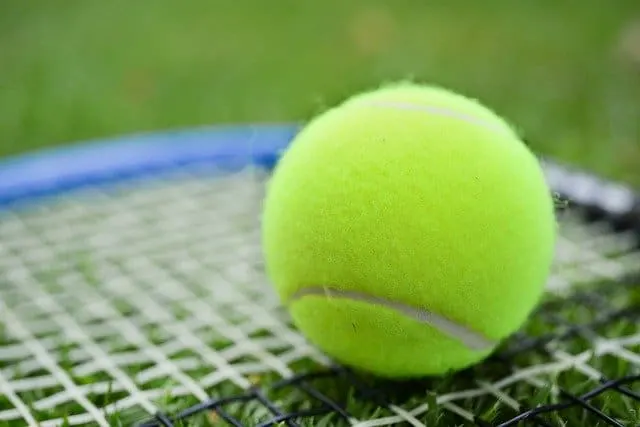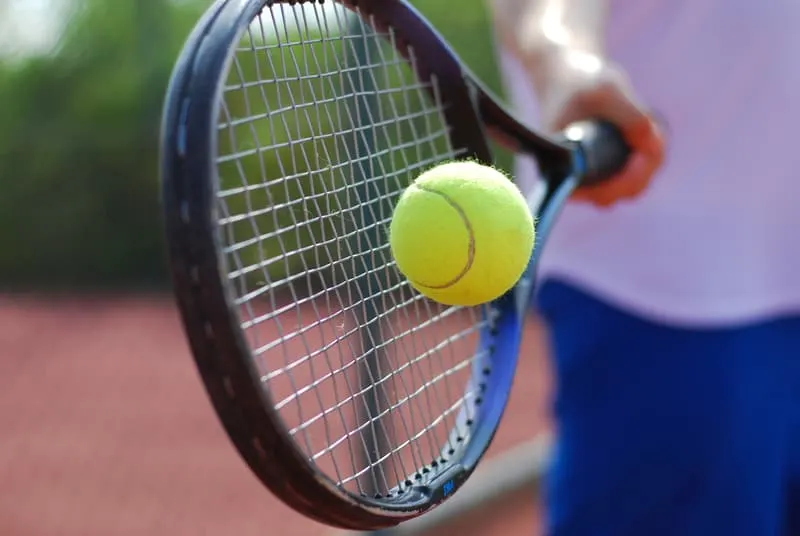
Tennis strings can make a huge difference in your game. Finding the right string setup is one of the most effective ways to improve your game instantly.
Some can offer you more spin, control and power so you have to choose carefully to pick one to complement your playing style.
In this article let’s take a look at the pros and cons of polyester tennis strings.
What Are Polyester Tennis Strings?
Polyester strings are one of the stiffer string types you can use in the game of tennis (nylon and natural gut are softer).
This string type is generally used by more advanced players.
4 Different Types of Polyester String
1. Traditional Polyester
These strings have high stiffness, but offer great control on your shots.
For example, check out the Wilson Revolve tennis string.

2. Textured or Rough Polyester
This string type offers excellent grip on the ball for extra spin.
For example, if you want to try out this type of string, take a look at the Kirschbaum Reel Black Shark Tennis String.

3. Shaped Polyester
This string also helps with grip and generating spin.
Check out the Solinco Tour Bite Soft Tennis String if you want to try this string type.

4. Co-Polyester
This string offers better comfort and more elasticity
The Babolat RPM Blast is one of the most popular co-poly tennis strings.
I’m currently using this, and I get fantastic spin and control on my shots. It doesn’t give a huge amount of power though.

Pros of Polyester Strings
- They are very durable and tough
- Provide excellent control for players who like the power game and long and fast tennis strokes.
- Helps to generate more topspin, which can give you more margin for error over the net on your groundstrokes
Cons of Polyester Strings
- Quite stiff to use, which means it’s not really suitable if you get shoulder, wrist or elbow injuries.
- Traditional polyester strings are not ideal for beginners, but suit intermediate/advanced players.
- Other string types such as nylon and natural offer better feel, particularly in and around the net.
- They don’t hold their string tension very well.
What Type of Player Should Use Polyester Strings?

This string type is ideal for players who like to rally a lot from the baseline. Furthermore, if you take big, fast swings when you hit your ground strokes, you’ll love the extra spin you can generate.
This can help you play aggressively, and give you more control so you won’t hit the ball long so often. Your shots will dip inside the opponent’s baseline and keep them pinned back in the court.
So if your playing style is very much of the Rafael Nadal and Serena Williams mould, polyester strings will really enhance your game.
Are Polyester Tennis Strings Good?
If you like to hit with a lot of spin, but don’t have a lot of power to your game, then you could consider a co-polyester, a shaped or a texture/rough polyester string. These are all a little softer, but still stiffer than nylon and natural gut.
You could even have a hybrid set-up by mixing polyester with a softer string type.
What Tension Should Polyester Strings Be?
String tension is a very personal choice for each tennis player.
However, the durability of polyester strings means you can experiment playing at different tensions quite freely.
I would recommend around 50lb as a good start and then tweak from there.
However, just bear in mind that poly strings can lose their tension quicker than other string types so you may need to restring you racket quite often, especially if you play regularly and take big swings at the ball.
I have my Babolat RPM Blast strung to 46lbs, which gives me a little more power on my shots to compliment the spin and control this string can offer.
